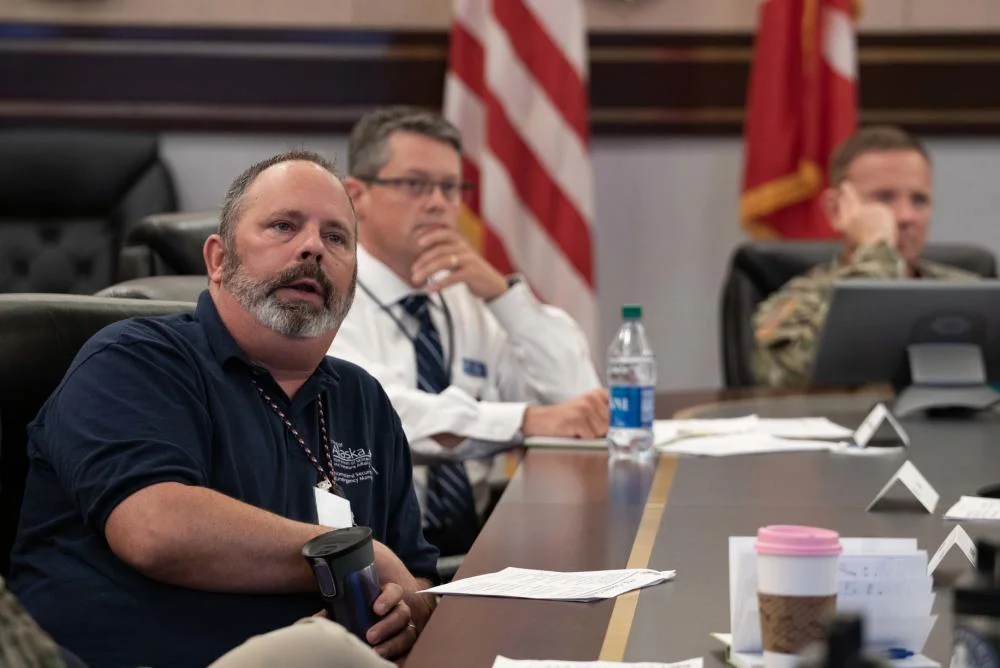DVIDS – News – PREPARE TO PROTECT: Commissary shoppers can purchase the items needed for their survival kits and save nearly 25% at checkout
FORT LEE, Va. – During September, National Preparedness Month focuses attention on the merits of planning for the next emergency.
Whether that emergency is manmade or by Mother Nature, service members and their families can count on their commissary benefit to help them save nearly 25 percent on items for their survival kits.
“We’re seeing floods in Eastern Kentucky, wildfires in California, and we know the season’s first major hurricane is right around the corner,” said Marine Sgt. Maj. Michael R. Saucedo, senior enlisted advisor to the DeCA director. “We don’t know when the next disaster will strike, but we do know that eligible shoppers can visit their commissary to get their emergency items now at significant savings.”
The Federal Emergency Management Agency’s theme for this year’s National Preparedness Month is “The life you’ve built is worth protecting. Prepare for disasters to create a lasting legacy for you and your family.”
The Preparedness Month website is separated into several compartments, most notably the following sections:
• Disasters and Emergencies: Subsections explain the disasters and hazards that could impact your location and give information on how to get emergency alerts and where to evacuate.
• Make a Plan: Subsections explain how to build an emergency kit, practice a fire escape plan, prepare for an emergency without going broke, stay “tech ready,” plan for assisting individuals with disabilities, preparing pets for emergencies and more.
To help service members and their families prepare their survival kits, DeCA sets up an annual severe weather promotional package from April through Oct. 31 with discounts on the following items: beef jerky and other assorted meat snacks, soup and chili mixes, canned goods, powdered milk, cereals, batteries, airtight bags, weather-ready flashlights, tape (all-weather, heavy-duty shipping and duct), first aid kits, lighters, matches, lanterns, candles, hand sanitizer and anti-bacterial wipes. Specific items may vary from store to store.
How do you prepare for the next crisis? Planning is the first step and emergency preparedness officials recommend a disaster supply kit that includes the following items:
• COVID-19 protection – reusable or disposable face coverings, disposable gloves, hand sanitizers, disinfecting wipes and hand soap
• Water – at least one gallon daily, per person (three-day supply for evacuation, two-week supply for home)
• Nonperishable foods – canned meats, fruits, vegetables, dried fruits, nuts, raisins, cereal, crackers, cookies, energy bars, granola, peanut butter, and foods for infants and the elderly (three-day supply for evacuation, two-week supply for home)
• Paper goods – writing paper, paper plates, paper towels and toilet paper
• Writing utensils – pens, pencils (manual pencil sharpeners) and markers
• Cooking items – pots, pans, baking sheets, cooking utensils, charcoal, a grill and a manual can opener
• First-aid kit – including bandages, medicines and prescription medications
• Cleaning materials – bleach, sanitizing spray, and hand and laundry soap
• Toiletries – personal hygiene items and moist wipes
• Pet care items – food, water, muzzle, leash, carrier, medications, medical records, and identification and immunization tags
• Lighting accessories – flashlights, batteries, candles and matches
• Battery-powered or hand-crank radio (NOAA Weather Radio, if possible)
• Duct tape and scissors
• Multipurpose tool
• Copies of personal documents (medication list and pertinent medical information, proof of address, deed/lease to home, passports, birth certificates and insurance policies)
• Cell phone with chargers
• Family and emergency contact information
• Extra cash
• Emergency blanket
• Maps of the area
• Blankets or sleeping bags
For more information about disaster preparedness, go to the DeCA website for lists of resources. For more resources to prepare for emergencies, go to Ready.gov and the Department of Homeland Security’s National Preparedness Goal webpage.
-DeCA-
About DeCA: The Defense Commissary Agency operates a worldwide chain of commissaries providing groceries to military personnel, retirees and their families in a safe and secure shopping environment. Commissaries provide a military benefit, saving authorized patrons thousands of dollars annually on their purchases compared to similar products at commercial retailers. The discounted prices include a 5-percent surcharge, which covers the costs of building new commissaries and modernizing existing ones. A core military family support element, and a valued part of military pay and benefits, commissaries contribute to family readiness, enhance the quality of life for America’s military and their families, and help recruit and retain the best and brightest men and women to serve their country.
| Date Taken: | 08.24.2022 |
| Date Posted: | 08.24.2022 10:28 |
| Story ID: | 427931 |
| Location: | FORT LEE, VA, US |
| Web Views: | 30 |
| Downloads: | 0 |
PUBLIC DOMAIN
This work, PREPARE TO PROTECT: Commissary shoppers can purchase the items needed for their survival kits and save nearly 25% at checkout, by Kevin Robinson, identified by DVIDS, must comply with the restrictions shown on https://www.dvidshub.net/about/copyright.







:no_upscale()/cdn.vox-cdn.com/uploads/chorus_asset/file/23278358/gfs_mslp_pcpn_frzn_ncus_fh24_168.gif)
/cdn.vox-cdn.com/uploads/chorus_asset/file/23277144/v0i1CrRw.png)
/cdn.vox-cdn.com/uploads/chorus_asset/file/23277151/c6FMlWpQ.png)
/cdn.vox-cdn.com/uploads/chorus_asset/file/23277152/x3XalqWw.png)
/cdn.vox-cdn.com/uploads/chorus_asset/file/23277160/qd7hDv_Q.png)
/cdn.vox-cdn.com/uploads/chorus_asset/file/23277169/UaA_XycQ.jpeg)
/cdn.vox-cdn.com/uploads/chorus_asset/file/23277186/YUIncRng.jpeg)
/cdn.vox-cdn.com/uploads/chorus_asset/file/23277189/TVYG12Ig.png)
/cdn.vox-cdn.com/uploads/chorus_asset/file/23277191/AGaFtBtQ.png)
/cdn.vox-cdn.com/uploads/chorus_asset/file/23278362/ecmwf_deterministic_KMSP_daily_tmin_tmax_6049600.png)
/cdn.vox-cdn.com/uploads/chorus_asset/file/23278363/gfs_deterministic_KMSP_daily_tmin_tmax_6049600.png)
/cdn.vox-cdn.com/uploads/chorus_asset/file/23278370/Temps.JPG)
/cdn.vox-cdn.com/uploads/chorus_asset/file/23278372/precip.JPG)
/cdn.vox-cdn.com/uploads/chorus_asset/file/23277223/S5KDsMYw.png)
/cdn.vox-cdn.com/uploads/chorus_asset/file/23275415/Moon.PNG)
/cdn.vox-cdn.com/uploads/chorus_asset/file/23277133/0ioIcaMg.jpeg)
/cdn.vox-cdn.com/uploads/chorus_asset/file/23277134/hRQGLfqQ.jpeg)
:no_upscale()/cdn.vox-cdn.com/uploads/chorus_asset/file/23278377/allfcsts_loop_ndfd__6_.gif)
:no_upscale()/cdn.vox-cdn.com/uploads/chorus_asset/file/23278378/p168i__6_.gif)
/cdn.vox-cdn.com/uploads/chorus_asset/file/23278379/ecmwf_deterministic_conus_total_snow_10to1_6913600.png)
/cdn.vox-cdn.com/uploads/chorus_asset/file/22163263/GOES17_GeoColor_NH_20190209.jpg)
/cdn.vox-cdn.com/uploads/chorus_asset/file/22163317/Todd_Nelson.jpg)
